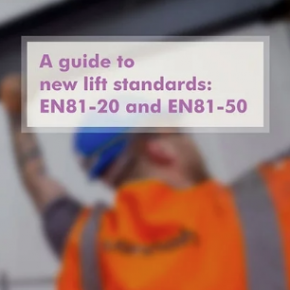
Stannah: Five FAQs on the EN81-20 & EN81-50 Lift Standards (2018 update)
NOTE: This post has been updated by Stannah for last year.
In September 2017, EN81-20 and EN81-50, two new safety standards for the construction of lifts and for the testing of lift components were introduced, bringing benefits in terms of safety and accessibility for both lift passengers and service engineers. Stannah has covered the most frequently asked questions…
1. What are the main differences between the standards and where do they apply?
Any passenger lift placed into service after the 31 August 2017 needs to comply with the new standards. The existing standards EN81-1 and EN81-2, introduced in 1998 are no longer in force and are applicable for lifts handed over prior to this date.
These new passenger lift standards provide greater lift safety, accessibility and comfort for both passengers and service engineers. The standards also make stipulations in terms of building design and interface.
To find out further details on the differences between the standards – take a look at Stannah’s guide.
Both new standards apply for passenger and goods passenger lifts that fall under the Lifts Directive. Therefore only traction and hydraulic passenger lifts are affected by these changes. These standards do not cover passenger carrying lifts with speeds below 0.15m/s or goods only lifts (Machinery Directive lifts).
2. What are the key changes to be considered when designing buildings?
EN81-20: 2014 introduces a number of changes to building requirements as they apply to the design of the lift shaft, specifically:
- As the allowance of space for refuge spaces has changed there may be a requirement for greater pit depth and headroom for the lift, particularly on smaller passenger lift sizes
- All glass must be laminated
- Shaft walls must be constructed with sufficient strength to withstand an impact force of 1000N
- Where fitted as part of a building’s fire strategy, lift shaft sprinkler systems can be fitted but their activation shall only be possible when the lift is stationary at a landing and the electrical supply of the lift and lighting circuits is automatically switched off by the fire or smoke system. (This does not apply to firefighting lift wells and machinery spaces however, where sprinkler systems are not permitted)
- The lift design and installation must allow for possible building shrinkage
- Responsibility for ventilation of the shaft falls to the building designer
Stannah’s passenger lift range offers an extensive range of choice and options, from 6 – 33 persons, both traction and hydraulic drives, to suit a variety of applications.
The company provides specific information on heat emissions on its builders work drawings along, with the other building requirements of the lift shaft and passenger lift design. All our passenger lifts comply with the latest standards and guidelines.
View passenger lift technical data
3. Have the design requirements for a passenger lift changed?
In the most part the design requirements of EN81-20 will be covered by the lift manufacturer. The only consideration is where non-manufacturer’s walls and floor finishes are being selected, e.g. bespoke lift finishes to match the building design. As the materials used for car floors, walls and ceilings have been updated, any finish must now meet the fire classification requirements outlined in EN 135001-1. The minimum classifications are:
- Ceilings : C, s2 and d0
- Floors: Cfl. s2
- Walls: C, s2 and d1
The ‘C’ and ‘Cfl’ classifications above refer to the reaction to fire and ‘s’ and ‘d’ refer to the classification of materials with regard to smoke and formation of flaming droplets and particles respectively.
If you are considering a finish a little different, Stannah is very proud of its ability to work closely with clients to achieve their vision, whilst complying to the relevant standards.
Or, alternatively, a bare lift car can be provided, ready for fitting out by other contractors, along with advise of the requirements.
4. What about current building projects with a lift?
As the time from initial order to lift handover can vary and sometimes construction sites are delayed, like other lift suppliers, Stannah has worked with all its clients to ensure wherever possible they have a lift that complies to the latest standards.
In the few cases where it is not possible to redesign the lift fully to BS EN81-20, there is the potential option to have the design approved as being in accordance with the Essential Health and Safety Requirements (EHSRs) of the Lift Regulations for those parts of the lift deviating from the standard, ensuring compliance through a Design Examination certificate from a Notified Body.
As part of this process it is important to demonstrate that the original installation was intended to be completed by 31st August 2017.
As the new standards came into force less than a year ago if you have a building project that has been underway since early 2017, it is worth checking with your lift supplier if you have any questions, to avoid any additional costs and/or site delays.
5. What about existing lifts?
The new standard only affects lifts installed after the 31st August 2017. However as these standards describe best practice, with the benefit of improved safety, it is likely that EN81-80, the refurbishment standard will be revised in line (as others within the EN81 series). If you are considering a lift refurbishment or lift modernisation, your local Stannah service branch will be able to advise on the latest technology and regulations to help update your lift.
Summary
As a reputable lift service provider, Stannah can not only provide you with the help and support you need to allow to meet these standards in the quickest and easiest way possible.
All its passenger lifts are fully compliant with the latest EN81-20 and EN81-50 lift standards, with the company happy to give advice on the changes.
These standards are only applicable to the supply and installation of Lifts Directive passenger lifts, however Stannah offer a wide range of lift solutions to move people and goods.
See Stannah’s range of products
For specific advice on the changes and how it affects your project, you can get in touch or fill in a contact form and Stannah will be happy to help
Visit Supplier's page
Latest news

17th April 2025
Nuaire shares expertise at Specifi Mechanical Services events in 2025
Indoor air quality and ventilation manufacturing specialist Nuaire is pleased to be exhibiting at the Specifi Mechanical Services events once again in 2025.
Posted in Air Conditioning, Articles, Building Industry Events, Building Industry News, Building Products & Structures, Building Services, Exhibitions and Conferences, Facility Management & Building Services, Heating, Ventilation and Air Conditioning - HVAC, Restoration & Refurbishment, Retrofit & Renovation
15th April 2025
West Fraser: CaberDek earns top marks from Home Counties carpentry specialist
A specialist carpentry sub-contractor covering housing sites across a large swathe of the Home Counties has come to value CaberDek from the West Fraser range for a variety of reasons: not least because the high quality panel product doesn’t destroy his operatives’ electric saws!
Posted in Articles, Building Industry News, Building Products & Structures, Building Systems, Case Studies, Restoration & Refurbishment, Retrofit & Renovation, Roofs, Timber Buildings and Timber Products, Wooden products
15th April 2025
GEZE: The Role of Access Control Systems in Enhancing Building Safety
Jane Elvins, Specification and Business Development Manager at GEZE UK, delves into the role of access control systems in enhancing building safety…
Posted in Access Control & Door Entry Systems, Architectural Ironmongery, Articles, Building Industry News, Building Products & Structures, Building Services, Doors, Facility Management & Building Services, Health & Safety, Restoration & Refurbishment, Retrofit & Renovation, Security and Fire Protection
11th April 2025
Don’t Do a Dave! It’s Time to Lock FIT Show 2025 in Your Calendar!
It’s that time again – FIT Show is back! You could be forgiven for thinking there won’t be much new to see when FIT Show returns to the NEC from 29 April – 1 May. Wrong!
Posted in Articles, Building Industry Events, Building Industry News, Building Products & Structures, Building Services, Continuing Professional Development (CPD's), Exhibitions and Conferences, Information Technology, Innovations & New Products, Restoration & Refurbishment, Retrofit & Renovation, Seminars, Training
 Sign up:
Sign up: